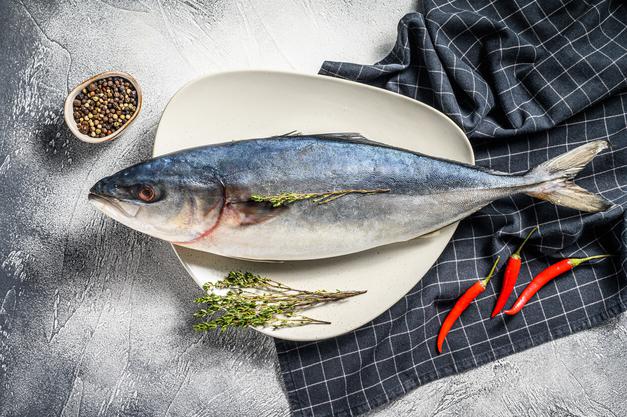Lemon or millet fish, a very tasty blue fish as versatile as the best tuna: what it is and how to take advantage of it in the kitchen
Much is said about the importance of regularly consuming oily fish in a healthy diet, but few species are usually named as an example. The popularity of salmon, tuna, bonito or sardines has relegated others as exquisite as lemon fish to second place, a highly valued fish among great chefs that we can also enjoy at home.
As usual among sea products, lemon fish is given other names such as lecha, amberjack, amberjack, cirviola or greenfinch, and in Japanese cuisine we can find it as kanpachi. Sometimes the same names are used for different types of the same family, depending on the capture or breeding area, which share very similar physical and organoleptic characteristics.
What should not be confused is this fish with the term 'milk', the sperm of the fish that is also used in cooking, or with the species of butterfish, which deserves a more in-depth analysis in a separate chapter.
Direct to the PalateWild sea bream is in full season (and it is much tastier than farmed): how to get the most out of itWhat is lemon or lecha fish: description and characteristics
The common and most present amberjack in our markets and restaurants is the Seriola dumerili species, saltwater blue fish of the carangid family (Carangidae), genus Seriola. Its nickname comes from the more or less diffuse yellowish line that crosses its body longitudinally on each of its flanks, more or less marked depending on the species, and more defined in larger adult specimens.
Like most carangids, it is an elongated fish with a flattened fusiform body, a slightly sharp rounded snout, with a slightly marked jaw and not too large eyes, somewhat larger in the Japanese buri. Its coloration presents the usual contrast between the bluish tones with gray or brown nuances of the upper part, compared to the bright white silver of the lower ventral area.
It has dark fins, with a small pectoral fin, a very aerodynamic dorsal fin that is usually accompanied by low lobes, as well as the anal fin. The caudal or tail fin has the typical V-shape, giving it great power and speed. The black mark that appears on the upper part of the eyes is also characteristic.
The largest specimens can easily exceed 170 cm in length and weigh 60 kg or even more, although fish weighing between one and three kilos are usually marketed.
Habitat, distribution and fishing
Carangid fish usually live in tropical and subtropical areas, avoiding areas of greatest frost. Lemon fish and its different types are widely distributed in waters around the planet, from the Indian Ocean to the Pacific and with a large presence in the Atlantic, reaching as far as the British Isles. It is very present in the Mediterranean and is highly appreciated in sport fishing.
It is an animal that usually lives in small groups when it is still young, tending more to a solitary life in adulthood. It does not usually go far from the coast, although it can go down to great depths, especially if it feels threatened. Predatory and voracious animal, it feeds on cephalopods, other smaller fish and any other species that it can find in its territory, including crustaceans.
The fishing season varies according to the area, highlighting the end of spring and mid-autumn as two of the best times, also to find wild specimens in fish markets and fishmongers. Today, however, amberjack is available year-round, thanks largely to aquaculture.
Although the commercial cultivation of this species began in Spain in the 1980s, it took time to develop efficient production due to various problems associated with reproduction and specific pathologies of the species. Currently, the recent good results and the increase in demand place aquaculture amberjack in Spain as one of the species with the greatest future prospects, especially in Andalusia, the Valencian Community and the Canary Islands. It is also raised in other regions of the world such as Japan, from where high-quality specimens are exported, or Hawaii.

I need to research how to buy your first house outside of a state you don't "live in" but as a home and not a rental property.
— Dolo Mon Jul 26 16:03:36 +0000 2021
Properties and benefits
The nutritional characteristics of lemon or millet fish are similar to those of other oily fish such as tuna or bonito. With an average energy intake of around 130-140 kcal per 100 g (depending on the piece and presentation), it offers high-quality protein, a moderate carbohydrate content and, above all, stands out as a source of unsaturated fats.
Aquaculture of Spain.Unsaturated fatty acids are known as "healthy" because they have beneficial effects on the body, which is also not capable of producing them on its own. Oily fish is one of the best sources of omega-3, whose consumption is associated with better cardiovascular health, helping to reduce the risk of heart disease, also thanks to its anti-inflammatory properties.
Lemon fish is also a good source of essential minerals and vitamins, especially from group B, and has a higher content of fat-soluble vitamins than white fish (vitamins A, D and E). The benefits of this fish are therefore comparable to those of salmon but being slightly lower in calories and less fatty, with a milder flavor that makes it better received by consumers of all ages.
How to use lemon fish in the kitchen
A large specimen of milk can be butchered in a very similar way to tuna, as demonstrated by the kitchens of great chefs specialized in dealing with fish of these qualities. Its fatty but balanced meat, firm and delicate, and the ease of removing the bones make it perfect for extracting various pieces and presentations with many applications in the kitchen.
Small or medium-sized specimens can be bought whole but clean, unopened, to cook on the grill, grill or oven, for example in salt or even papillote, or simply stuffed with lemon, tomato and onion. Whole but open as a book, it is also very grateful, grilling it on the back as if it were a sea bass or horse mackerel.
The fillets or loins are also very comfortable to grill, steam or even bake, in short and controlled cooking so that they do not overcook. The thickest cuts, with their firm and white meat, are ideal for battering and frying to the point, or for cooking a brothy or dry seafood rice that little else is needed if its bones are used to make the fumet.
The ventresca and the ijada, as in the tuna, are highly appreciated for grills and all kinds of more or less traditional preparations, admitting classic accompaniments such as tomato sauces or other more exotic ones with Asian, spicy or spicy touches. The liver of lemon fish is also used, excellent as a creamy pâté, and the roe, it also offers magnificent salted fish.
It is a highly appreciated fish for raw and marinated preparations such as sushi cuts, sashimi or usuzukuri, also Peruvian-style tiraditos, ceviches and more or less seasoned tartars.
Subscribe to receive our recipes, nutrition information and gastronomy news every day.Grilled lemon fish recipe
A whole medium-sized amberjack, weighing about 1,200-1,500 g, is perfect for cooking like a sea bass for a family of three or four. In our recipe we give the basic indications to do it on the barbecue, but the same idea can be applied to do it on an electric grill or on the griddle.
You just have to ask the fishmonger to leave the fish clean of viscera and whole, being able to leave the roe inside if it had them, since they will give more flavor. A side of roasted or fried potatoes or some baked vegetables will be the perfect side dish.
Ingredients
for 4 peopleHow to make grilled lemon fish
Difficulty: EasySeason the fish inside to taste, lightly brush it with a little extra virgin olive oil and put it in a barbecue grill or cage. We place the grill low and roast the fish for about seven or eight minutes on each side, so that the interior cooks well.
The time will depend on the weight and thickness of the piece. Then, we put the fish almost directly on the coals for a minute so that the skin has an extra crunch, but be careful when the skin begins to brown, so as not to overcook or burn it excessively.
If we do it on an electric grill or grill, we raise the temperature to the maximum and mark it by pressing carefully to leave the skin very crispy, always controlling the point so that it does not burn.
Thank you! 6 votesPhotos | iStock - Diego Delso - Lisa Pinehill - NOAA - サフィル - TTSengEn Directo al Paladar | The poor cousin of cod is called stoker, and it's great: how to take advantage of this versatile and cheap fishEn Directo al Paladar | Corvina, an exquisite seasonal white fish to enjoy all year round: how to prepare it and five recipes to enjoy it

![47 best antiage nutritive cream in 2022 [based on 326 reviews]](https://website-google-hk.oss-cn-hongkong.aliyuncs.com/drawing/article_results_6/2022/2/27/1918fc37c66ad30564173e69d9df88a0.jpeg)








